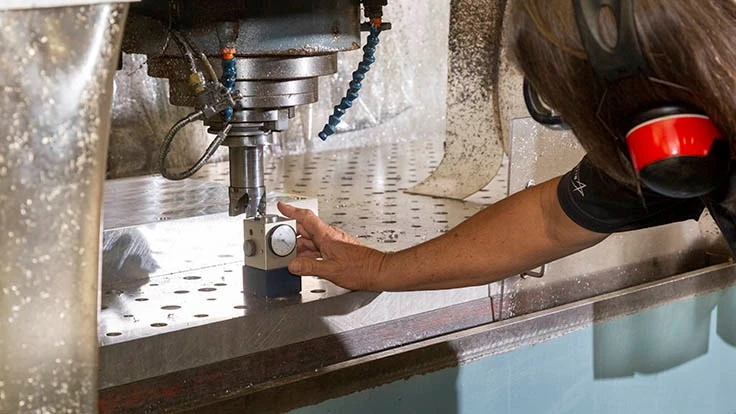
Pictured, a Lockheed Martin technician at their Palmdale, California, facility prepares a machine to shave the first piece of NASA’s X-59 QueSST aircraft, which later will be integrated into the overall structure. Image credit: Kevin Robertson/Lockheed Martin
NASA and Lockheed Martin have now taken a step closer to a future with faster-than-sound air travel over land.
Lockheed Martin Aeronautics Company of Palmdale, California, recently began manufacturing the first part of NASA’s X-59 Quiet SuperSonic Technology (QueSST) aircraft. When completed, NASA will use the X-59 to study how reducing the sonic boom heard from traditional supersonic jets to a quiet sonic “thump” could lead to acceptance of supersonic flight over land.
“We’ve reached an exciting milestone not only for NASA but for airliners and passengers wishing to arrive to their destination in half the time,” said Craig Nickol, the NASA project manager for the Low-Boom Flight Demonstrator project. “Manufacturing the first part of the X-59 is a step on a path that leads to the completion of an exciting research aircraft, quiet supersonic flight and new markets for faster air travel.”
"The start of manufacturing on the project marks a great leap forward for the X-59 and the future of quiet supersonic commercial travel," said Peter Iosifidis, Low Boom Flight Demonstrator program manager Lockheed Martin Skunk Works. "The long, slender design of the aircraft is the key to achieving a low sonic boom. As we enter into the manufacturing phase, the aircraft structure begins to take shape, bringing us one step closer to enabling supersonic travel for passengers around the world."

Illustration of the X-59 QueSST as it flies above
NASA's Armstrong Flight Research Center in
California. Credit: Lockheed Martin
When completed, the single-pilot experimental aircraft will go through a series of tests to prove its performance. Then the X-59 will fly over a number of U.S communities, collecting data on how the public responds to the quiet “sonic thump.” U.S. and international regulators will use the data to potentially change the rules that currently ban supersonic flight over land.
NASA selected Lockheed Martin to build, design, and conduct initial flight tests of the X-59. Work under the contract began April 2 and runs through Dec. 31, 2021.
NASA has officially committed to a development timeline that will lead to the first flight of its X-59 Quiet Supersonic Technology (QueSST) aircraft in 2021.
This critical milestone comes after a rigorous review, Key Decision Point-C (KDP-C), that confirmed NASA’s continued support of the X-59, in terms of funding, and established an achievable development timeline for NASA’s first piloted, full-size X-plane in more than three decades.
“This aircraft has the potential to transform aviation in the United States and around the world by making faster-than-sound air travel over land possible for everyone,” said NASA Administrator Jim Bridenstine. “We can’t wait to see this bird fly!”
X-59 is designed to cruise at 55,000ft at a speed of about 940mph [Mach 1.4] and create a sound about as loud as a car door closing, 75 Perceived Level decibel (PLdB), instead of a sonic boom.
Get curated news on YOUR industry.
Enter your email to receive our newsletters.Latest from Aerospace Manufacturing and Design
- MagniX, Robinson to develop battery electric R66 helicopter
- Zero-point clamping modules
- Hartzell electric engine propeller earns FAA approval for AAM
- Thin profile flame and thermal barrier
- Guill Labs offer materials and extrusion testing
- High production vertical honing systems
- July Manufacturing Lunch + Learn webinar with OPEN MIND Technologies
- July Manufacturing Lunch + Learn webinar with Techman Robot





